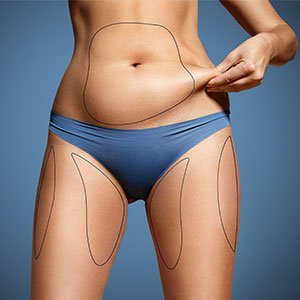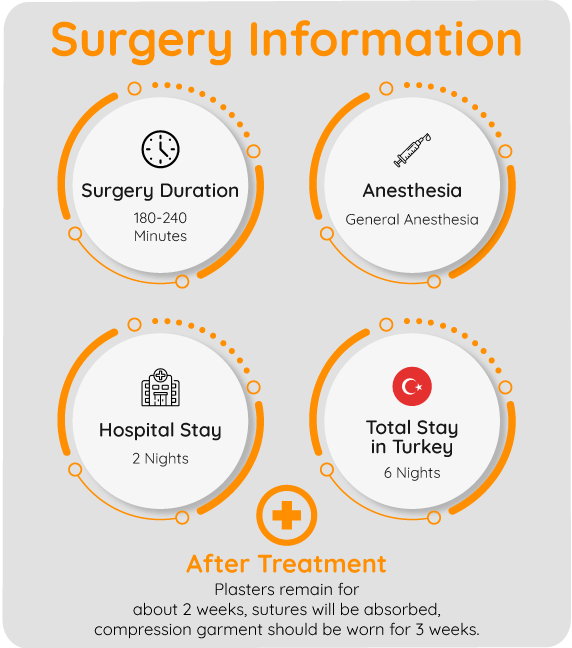Post-bariatric surgery in Turkey, which is a type of body contouring surgery after weight loss, is a transformative procedure designed to address the physical changes that occur after significant weight loss. This cosmetic surgery in Turkey includes a range of treatments, each targeting specific areas of the body affected by excess skin and tissue due to substantial weight loss. Whether you’ve undergone gastric bypass, lap band, or other weight loss procedures, loose skin after weight loss surgery can become a concern.
We’ll get back to you within one business day (via e-mail & WhatsApp)
After achieving significant weight loss, many individuals find themselves dealing with the challenge of excess skin that doesn’t conform to their new body shape. This saggy skin can lead to self-consciousness and impact self-esteem, offsetting the confidence gained from weight loss. Post-bariatric surgery steps in as a powerful solution, helping to contour the body by removing excess skin and improving overall appearance.
Recognizing the diverse needs of patients, our procedures extend to the back as well as other more common areas. Often, an upper back lift is recommended to eliminate excess skin and redefine the upper back’s appearance. In cases where the lower back requires attention, a gluteal lift, commonly known as a buttock lift, can be an ideal choice, providing uplifted and rejuvenated buttocks.




The post-bariatric surgery process in Turkey encompasses a range of specialized options, meticulously designed to address specific body areas and meet individual transformation goals.
But these aren’t the only procedures we offer. While the classic tummy tuck is available to address abdominal concerns, certain post-bariatric patients might benefit from a more comprehensive approach known as the ‘Fleur de lis tummy tuck’. This advanced procedure involves a more extensive transformation to address specific challenges faced by this group of patients.
In situations where both the tummy and lower back areas require simultaneous attention, a transformative procedure known as the Belt Lipectomy comes into play. This comprehensive intervention, targeting the entire circumference of the midsection, creates a harmonious transformation, resulting in a sculpted and rejuvenated appearance.
Detailed information about any of these procedures can be found here on the Badge Clinic website, or you can talk to your Badge Clinic consultant about the surgeries that you’re considering.
When contemplating post-bariatric surgery in Turkey, several factors come into play. First, individuals should have reached a stable weight following their primary weight loss procedure. This ensures the best possible outcomes. It’s also important to set realistic expectations and understand that post-bariatric surgery is not a substitute for weight loss, but a refinement of the results achieved. Consulting with experienced surgeons at Badge Clinic can help in assessing candidacy, understanding the recovery process, and comprehending potential risks.




Badge Clinic stands as a renowned destination for surgery after weight loss. Our state-of-the-art facilities and expert surgeons provide a safe and supportive environment for patients seeking transformation. The clinic’s commitment to excellence is reflected in our reviews and patient testimonials, showcasing the life-changing outcomes they’ve facilitated.
Choose Badge Clinic today for expert care, personalized treatment plans, and a renewed sense of confidence through post-bariatric surgery.
In general, good post-bariatric surgery candidates are:
Under the guidance of your physician, a customized plan is tailored to your needs and desired outcomes.
To ensure your comfort, appropriate medications, such as intravenous sedation or general anesthesia, are administered during the procedure. Your doctor will recommend the optimal choice for you.
Body contouring surgeries need substantial incisions for skin removal. The incision’s length and pattern depend on factors like excess skin amount, its location, and your surgeon’s judgment. Advanced techniques enable incisions to be strategically placed, often concealed by clothing.
Body contouring is often conducted in stages, aligning with your unique condition and goals. Just as weight loss took time, the contouring results might require equal patience.
Expect to have dressings covering your incisions following the body contouring procedure. Small tubes may also be placed temporarily beneath the skin to drain any extra fluids. You’ll receive clear instructions for caring for your surgical sites, taking prescribed medications, and monitoring your overall health. During your recovery at home, remember to avoid bending and lifting, especially after procedures involving the abdomen or thighs. If these areas are treated, follow guidelines to protect internal sutures and consider using pillows to support your knees while sleeping. To lower the risk of blood clots, start walking as soon as possible and stay well-hydrated to minimize the chances of developing deep vein thrombosis (DVT).
The outcomes of loose skin after weight loss surgery will become noticeable almost instantly, reflecting the impact of substantial weight loss. To achieve a body contour that aligns with your new weight and proportions, it’s crucial that you realise there will be scarring from this procedure.
The effects of body contouring are typically long-lasting, provided you maintain a consistent weight and overall fitness level. While natural aging may lead to some loss of firmness over time, much of the initial enhancement should persist.
During the healing phase, it’s crucial to avoid undue pressure, motion, swelling, or friction around the surgical incisions. Your doctor will offer specific guidelines on self-care to ensure a successful recovery.
Get more information on the Badge Clinic Instagram page about post-bariatric surgery results.